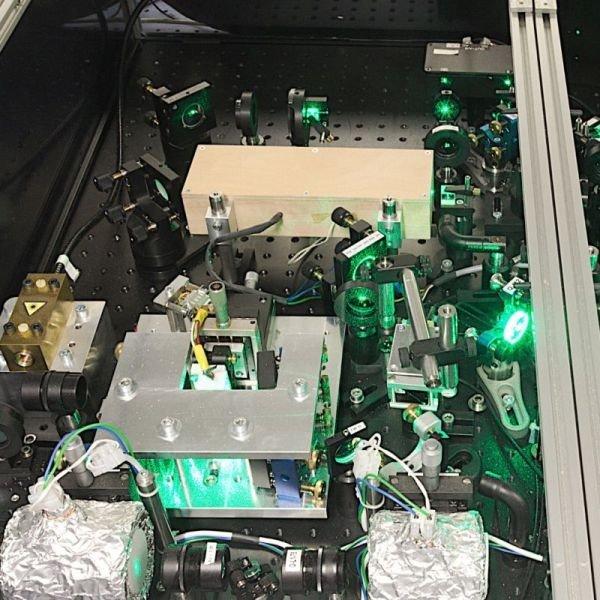For centuries, clocks have been evolving to track time with ever more precision. Today’s atomic clocks use the electrons in cesium atoms, oscillating around nine billion times each second, to set the current standard, Coordinated Universal Time or UTC. But a new contender is on the horizon in the form of a new generation of atomic clocks that measure electronic oscillation in the visible, not the microwave range, upping their precision by a factor of 100,000. These ultraprecise chronoscopes can measure time down to a tiny fraction of a second, to the 19th decimal place. If the entire age of the known universe was measured, this would represent a tenth of a second.
Current optical clocks are still unwieldy room-filling behemoths. To shrink them down to a manageable size, the German Ministry of Education and Research is funding the ISABELLA project. The partners on the project are focusing their efforts on miniaturizing the lasers that form the backbone of the clocks by enabling them to measure the oscillation of atoms. It is complex work: Atoms are always moving, immensely fast and unpredictable. For the clocks to measure their oscillation, the atoms first need to be captured and cooled down to near absolute zero to slow them down. The lasers need to be extremely precise to do this, which has resulted in the enormous size of current clocks of this nature. This is where the researchers on the ISABELLA project are trying to change things with a new technology that shrinks the lasers down to size.
A versatile tool for research and public life
Optical clocks not only help keep us on time, they also contribute to some of the key questions of fundamental physics: The improved precision can mean that e.g. some of the constants of the universe can be calculated more perfectly. This precision is extremely important, in order to be able to describe our world and the universe around us with pinpoint accuracy and propel our academic knowledge forward.
A second use cases can be found in applied science, because modern optical clocks are useful sensors for tracking changes in the gravitational field. They can contribute to a more precise map of the Earth’s gravitation, which would enable geologists to predict the movement of tectonic plates with more certainty, locate petroleum or minerals underground, or catch the build-up of magma inside volcanoes. As highly precise sensors, the clocks are also attractive for climate science, as they could keep score of changes in the sea level.
The highly precise clocks have a third potential use in satellite navigation systems like GPS. Current navigation satellites are equipped with miniaturized atomic clocks that work with microwaves. By integrating optical atomic clocks, the accuracy of these systems could increase by a factor of 100, which would represent a great leap forward for safer driverless cars.
From lab-filling machines to small quantum devices
The individual components of the laser can only function together, which is why the partners on the ISABELLA project are also working closely with each other. The team based at the Heinrich Heine University of Düsseldorf is, for instance, cooperating with VACOM Vakuum Komponenten & Messtechnik GmbH to build a robust resonator in a miniaturized vacuum chamber. Over at sensor photonics GmbH, the semiconductors are built for the lasers, and the project coordinator Sacher Lasertechnik GmbH is assembling all components in a single laser system.
At the Fraunhofer Institute for Reliability and Microintegration IZM, the team around the nuclear physicist Dr. rer. nat. Wojciech Lewoczko-Adamczyk has taken on the assembly of photonic chips and the waveguides needed for them. “We are seeing a historic moment for optics: Our current technology is still massive in size, but very sensitive in use. However, with the components getting smaller and more reliable, transportable and more practically useful systems could enable quantum technologies with ultracold atoms. Our mission is to develop the chips and photonic waveguides to make this possible. We are doing this by matching our optical connectors to the relevant wavelengths for atomic clocks and integrating selective filters that can help lasers emit light at very specific, narrow wavelengths”, Lewoczko-Adamczyk explains.
By the planned end of the project in late 2024, the partners will be able to demonstrate highly integrated, compact laser systems ready for industrial use to manipulate ultracold atoms. The researchers are also investigating ways to scale the technology up for more affordable and cost-efficient optical atomic clocks.
About ISABELLA
The ISABELLA project, working on hybrid-integrated and frequency-stabilized laser systems for the reliable manipulation of ultracold atoms in transportable systems, is scheduled to run from 2022 to 2024. The project consortium includes representatives from science and industry, including Sacher Lasertechnik GmbH as the coordinators and sensor photonics GmbH, VACOM Vakuum Komponenten & Messtechnik GmbH, the Fraunhofer Institute for Reliability and Microintegration IZM, and the Department of Mathematics and Natural Sciences and Institute for Experimental Physics of the Heinrich Heine University of Düsseldorf. Support for the work includes funding from the Ministry of Education and Research as part of the “Enabling Technologies for Quantum Technology” program (funding ID 13N16060).
Fraunhofer-Institut für Zuverlässigkeit und Mikrointegration IZM
Gustav-Meyer-Allee 25
13355 Berlin
Telefon: +49 (30) 46403-100
Telefax: +49 (30) 46403-111
http://www.izm.fraunhofer.de
Presse
E-Mail: susann.thoma@izm.fraunhofer.de
![]()
